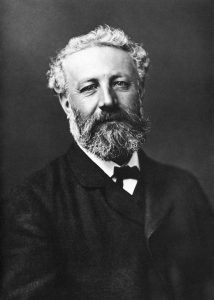

What Did Jules Verne Write?
2 min read
Share
Jules Verne (1828-1905) was a French author who helped open the way to today’s science fiction. He wrote a wide range of literary works, including scientific essays, plays, and short stories.
His work combines scientific facts with adventure fiction; his first book in the Voyages Extraordinaires, or Extraordinary Journeys, series (1863-1910), was published by Pierre-Jules Hetzel. The novel was called Cinq semaines en ballon or Five Weeks in a Balloon.
The book was first serialised in Pierre-Jules Hetzel’s Le Magasin d’éducation et de récréation but it quickly became an international bestseller. Verne produced more than 60 literary works in the Extraordinary Journeys series over more than 40 years.

Positivist Work (1862-1886)
Many of the science-adventure books written during this period of time resulted from Hetzel rejecting his second novel, a dystopian story titled Paris au XXe siècle or Paris in the 20th Century. During this time, Verne expanded both his fortune and worldwide fame, collaborating on play adaptations of his work in several European countries.
Pessimist Work (1886-1905)
Between 1886 and 1905, Jules Verne’s work changed into an exploration of the dangers of technology due to hubris-filled scientists. This shift from pro-science, ideological tales of discovery and exploration occurred alongside tempestuous times in his life, such as successive deaths of both his mother and his mentor Pierre-Jules Hetzel, financial difficulties, and becoming partially crippled.
Around the World in 80 Days, 1873
Considered Verne’s most popular book in English, Around the World in 80 Days differs from his usual science fiction and futuristic work. It contains a portrayal of the British Empire just before it peaked, written down by an outsider. This book has been adapted to shows, films, and plays – in fact, why not join us for our Around the World in 80s Days?

Journey to the Centre of the Earth, 1864
The second book on the author’s series Voyages Extraordinaires or Extraordinary Journeys (1863-1910), Journey to the Centre of the Earth is an important work combining both adventure fiction and scientific facts. Some of the novels in the series laid down the groundwork for the science fiction genre.
Twenty Thousand Leagues Under the Sea, 1870
A classic science fiction and adventure novel, Twenty Thousand Leagues Under the Sea has been a highly-acclaimed novel since it was published. It’s considered to be one of Jules Verne’s premiere adventure books and one of his best works.
The Nautilus, Nemo’s ship, has accurate descriptions of submarines’ features. This technology was still very primitive in the 19th century; Verne studied the model of French submarine Plongeur in 1867 and used it as inspiration in the novel.
20,000 leagues represent almost 50,000 miles (or 80,000 km), which are almost double the Earth’s circumference. As such, the title of the book doesn’t refer to the depth travelled but the distance travelled under the sea.























